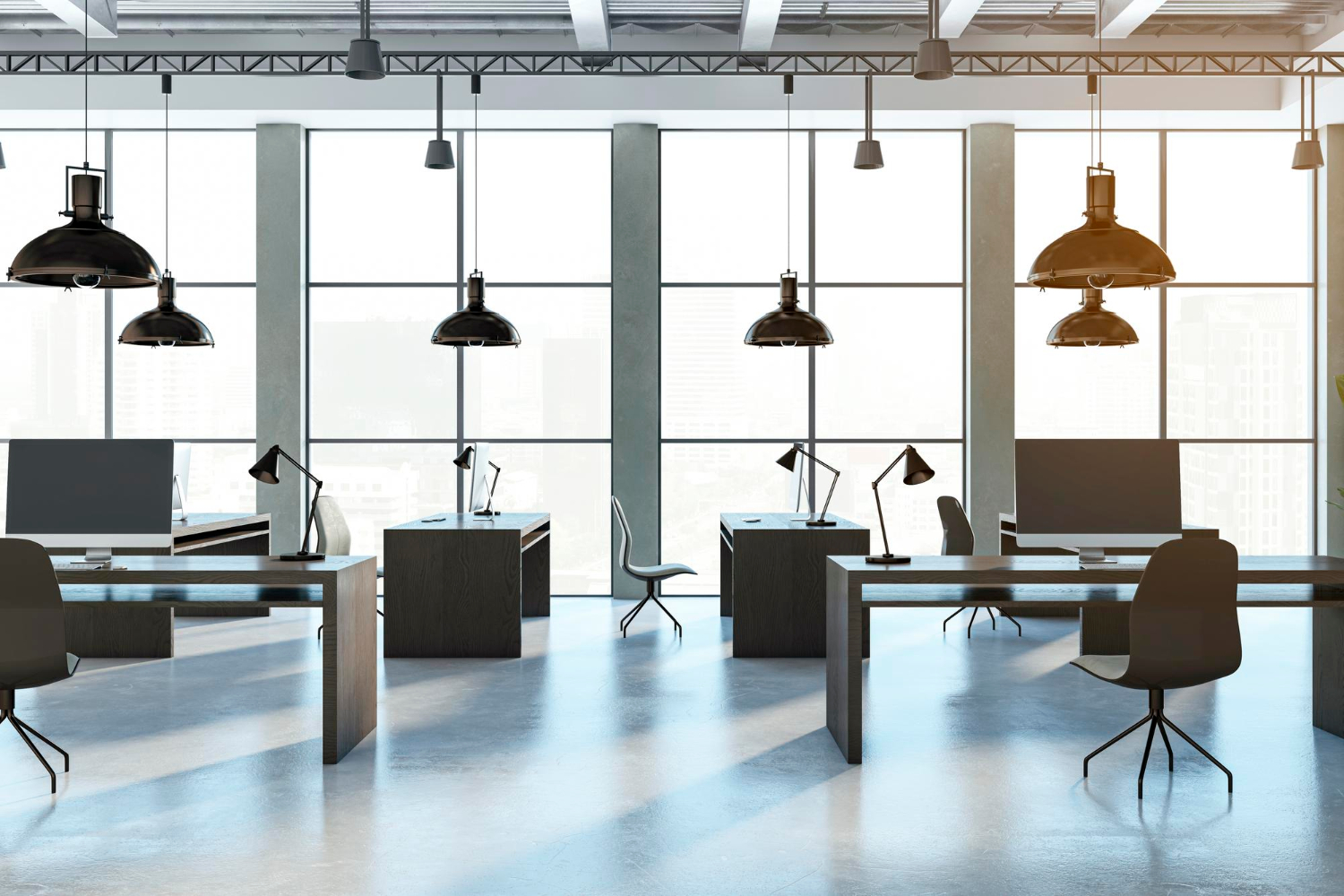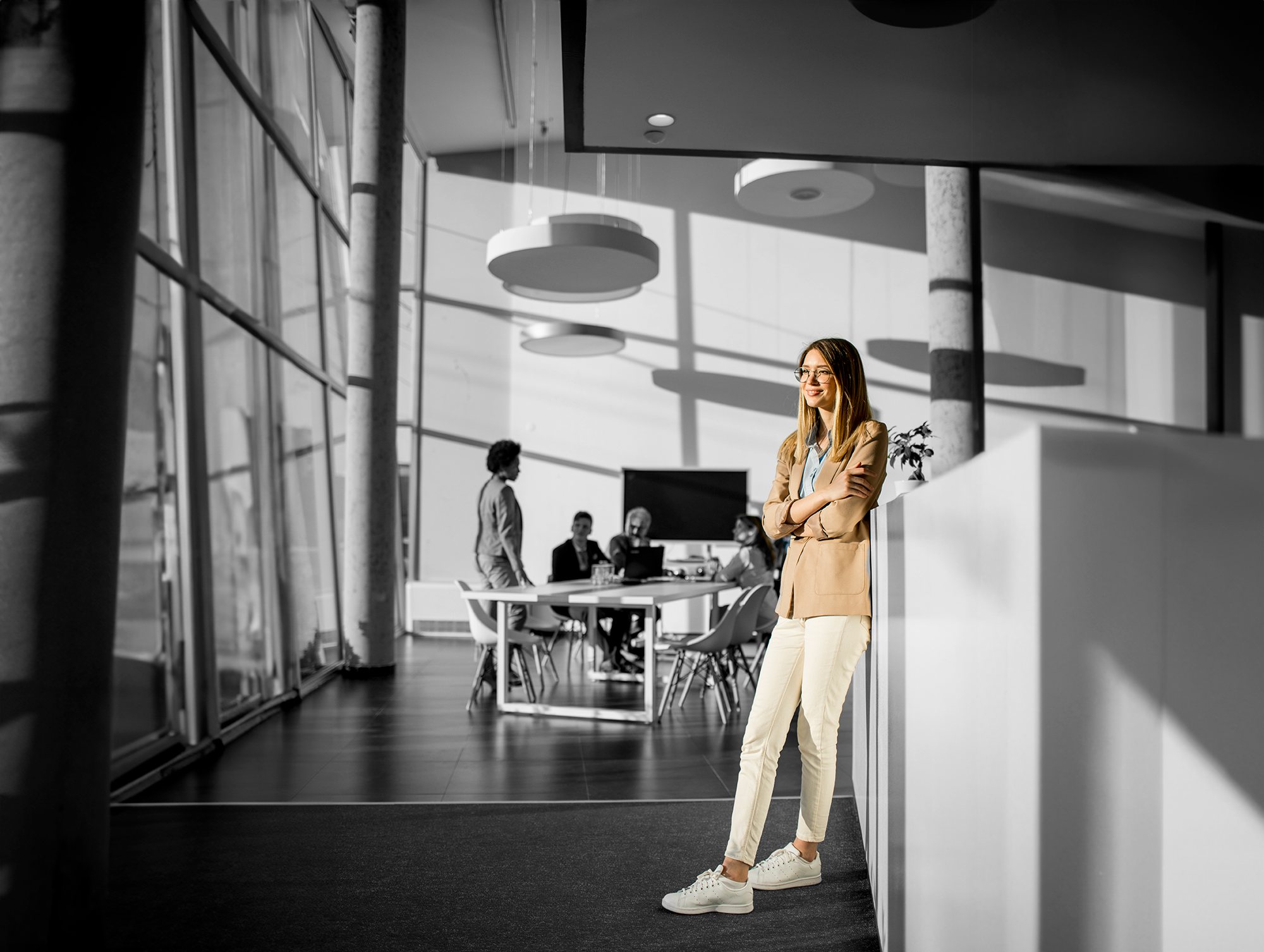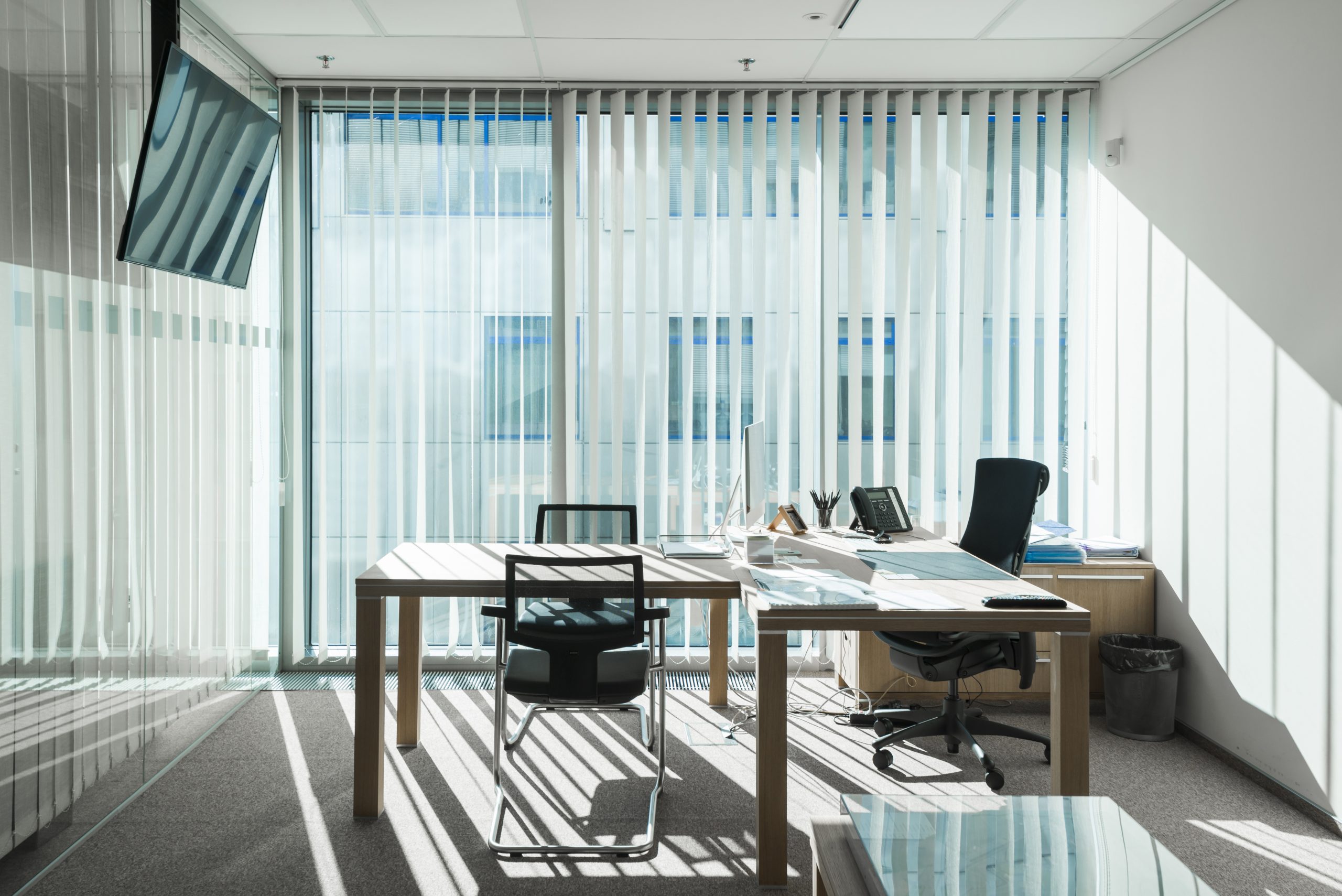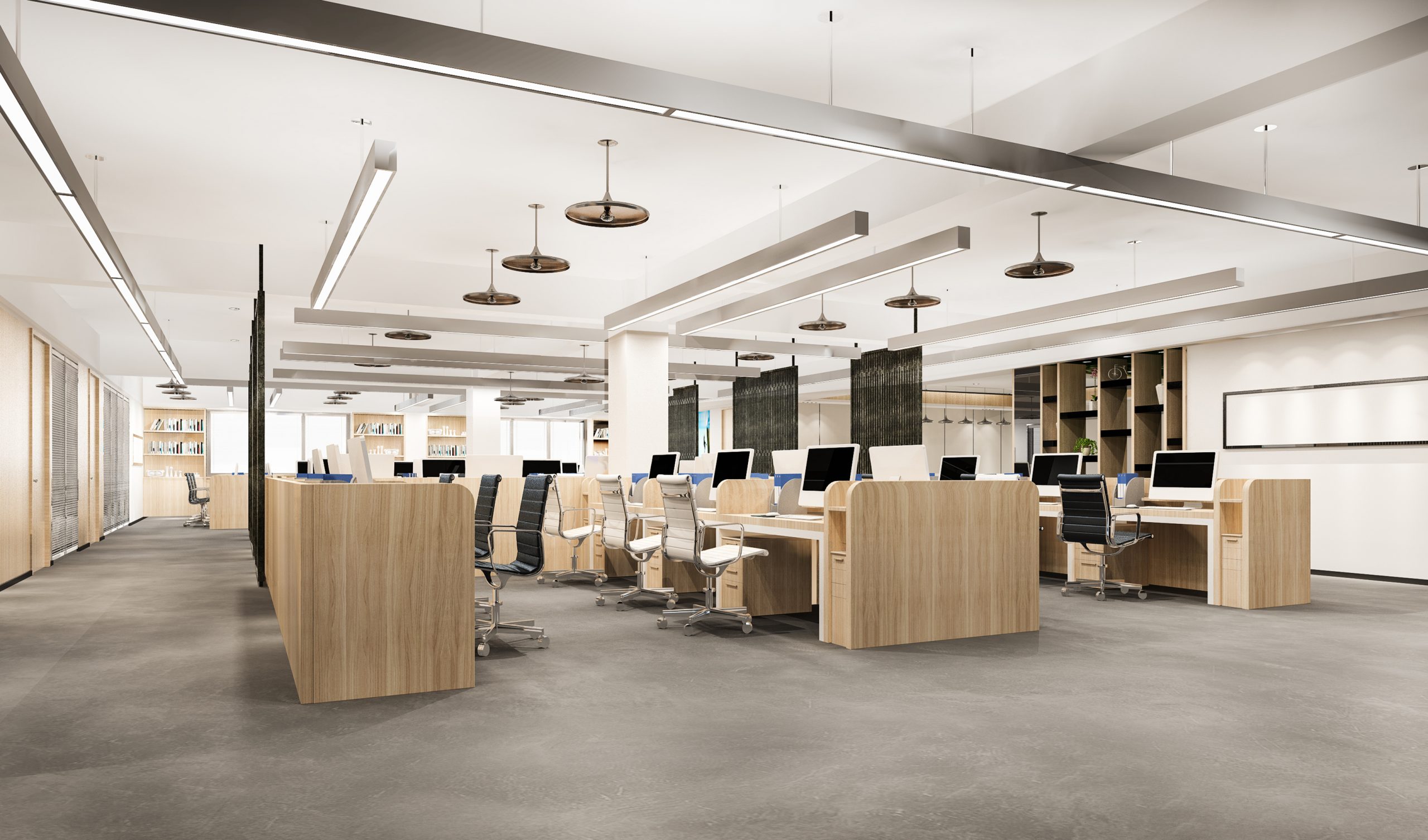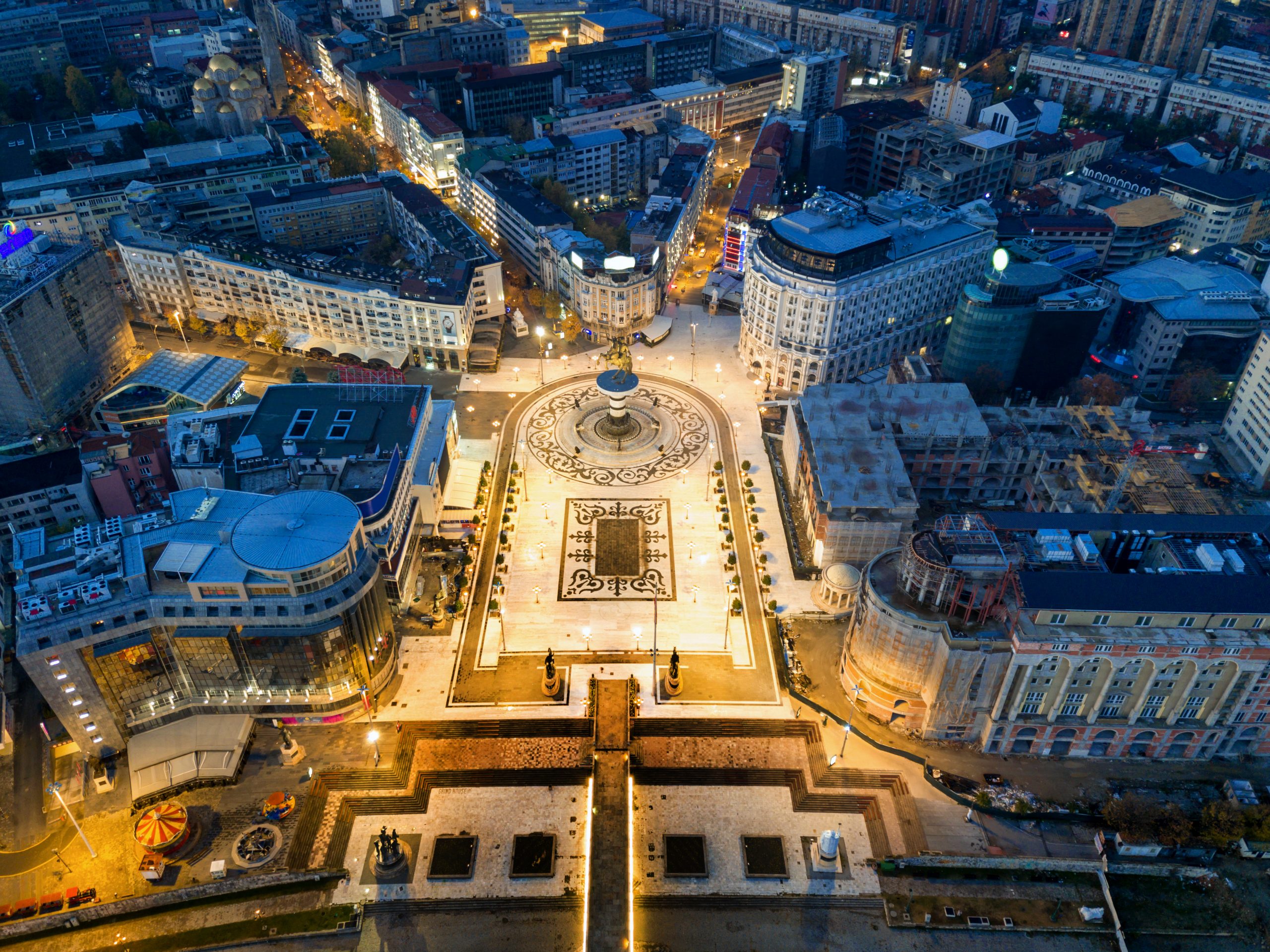-
Advice
Modern office spaces trends
The Covid-19 pandemic changed the world in the last two years. Many industries had to quickly adapt to the new reality, which affected all segments of our lives. Many companies have tried to design and improve their business premises so that they can maximize the satisfaction of their employees at the workplace.
What does the workspace of the future look like?
The future of work depends on flexibility, technology, and employee experience. That’s why more and more companies are trying to reshape the work environment and better align office design with their brand and culture. Modernizing the workspace also provides a unique opportunity to bring health and wellness into the everyday employee experience.
Basic requirements – Air and lighting
Air quality and lighting can significantly affect employee well-being and productivity. With 80-90% of days spent indoors, where concentrations of some pollutants are two to five times higher than outdoors, it is not surprising that natural light is an important factor in planning office spaces. Access to natural light is the number one attribute employees want in their office space. Improper lighting disrupts circadian rhythms, and natural light can have a significant impact on everything from mood to creativity and concentration.
Apart from natural lighting, office lighting is also important because it affects the mood of the person staying in it and encourages maximum productivity if it is adequately positioned.The benefits of fresh air are numerous. The brain uses 20% of the air we breathe, so fresh air ultimately leads to clearer thinking, focus, and concentration. In addition to the psychological benefits of fresh air, there are also physiological benefits. When working indoors, breathing tends to be shallow.
When you’re outdoors, moving, whether you’re walking or jogging, it encourages increased diaphragmatic breathing. Breathing fresh air has other health benefits. Viruses and bacteria have a reduced survival rate when air is constantly circulating. Poor quality indoor air can lead to a variety of ailments, including headaches, fatigue, and sometimes chronic illnesses, such as allergies and respiratory diseases.

End of endless sitting
There is more and more scientific evidence about the harmful effects of prolonged sitting on health. It is a well-established fact that sitting has become the cause of many diseases, studies have linked long-term sitting to heart disease, type 2 diabetes, cancer, and other health conditions, and globally, 6% of deaths are attributed to physical inactivity.
The office of the future, therefore, includes a flexible design in which employees can choose where and how they will work. This requires movement throughout the day in open space offices, private offices, meeting rooms, phone booths, lounges, recreation and dedicated meditation rooms, kitchens, and other common areas. Practical applications of this principle also include ergonomic office chairs and sitting desks, which encourage good posture to avoid strain while sitting. Hybrid office spaces are also used to encourage movement and reduce repetitive strain.

More colors and artwork in the workplace
Color can make a big impression. Although many companies prefer to use only their corporate color palette, it is always advisable to consider other tones that subtly indicate what certain spaces are designed for. Soft colors improve concentration, and vivid colors improve collaboration and creativity.
Traditional offices had uniform furniture – chairs of one type and all the same color. This idea that everything has to match perfectly is outdated. Color ultimately has a significant impact on employee mood and productivity. Different styles, brands, finishes, and fabrics of office chairs can help create a fun office environment to work in.
Creating office interiors where employees can feel relaxed and friendly can be achieved in other ways, such as through artwork. Artistic work in the workplace has numerous positive effects. It has a powerful effect on mental health and well-being by creating a sense of calm and improving productivity, creativity, and mood in the office. Art is also a key part of the company’s brand identity. It forms unique elements in the workplace that give the office an authentic feel, a sense of community, and belonging.

Creating quiet spaces
With all the benefits of open space, there are also challenges. Studies have shown that more than 50% of people have difficulty concentrating in open spaces. According to the World Health Organization (WHO), noise is an underestimated threat that can cause serious health problems and interfere with work performance.
Complaints about a noisy office are often dismissed too quickly. Companies can mitigate noise through carpets, furniture, and ceilings, which are designed to absorb sound, and sound masking systems, as well as by setting aside dedicated spaces for so-called deaf rooms, where employees can do work, meet or talk in peace.

Biophilic office space
Forward-thinking companies are embracing biophilic design with natural lighting, natural ventilation, and views of nature and flora, from green walls and potted plants to corporate gardens and outdoor workspaces.
How does the office benefit from bringing nature indoors? Not only do plants affect memory, but they can also affect the mood of employees, lower stress levels, and have various other health benefits.
This principle of interaction with nature is embedded in the office in the form of biophilic office design, from the inclusion of plant life in different parts of the office to living walls and rooftop gardens. Plants have numerous benefits, including separating and zoning office space, improving office aesthetics, and improving air quality.
Focus on health and wellness
The topic of workplace wellness has been around forever. Although this was once considered snobbery, today it is becoming an essential topic in all organizations. This became especially important after the pandemic, with the return of employees to offices.
More and more companies are becoming health-conscious and adopting proactive workplace wellness programs. They promote them as part of a recruitment package in a competitive market to attract the best talent, who want to work in the best possible environment. As a result, workplace well-being has moved to the top of employee priorities. But workplace wellness means different things to different organizations.
The workplace today is something to watch out for, it’s focused on the individual and that’s likely to stay the same for a while as workplace well-being becomes more important. Companies have also realized that workplace stress is the biggest health issue facing employees and are consequently working to create a more relaxed and healthy work environment for everyone.
As employers rethink their workplaces, a key component of well-being is at the fore: social connectedness. According to many reports, support for social health at work is relatively low, with only 34% of workplace designs supporting socialization. A brilliantly designed space that matches the employer’s brand and includes areas for social interaction can create a true sense of belonging among employees

-
Facilities Management
Why Professional Property Management is becoming more important?
Property Management (PM) is the day-to-day supervision of residential, commercial or industrial real estate by a third party, usually a professional manager or property management company. Property management has long been considered an expense, but today it has become an integral part of a company’s success.
Real estate management has become a very important service for most investors because it includes the entire management and control of all processes related to the exploitation of the building, with special reference to commercial and financial management services. The most dynamic segment in property management is certainly the segment of commercial buildings.
Considering that the real estate market is intensively developing in all segments in addition to office buildings, increasing demand of these services is needed in the segments of residential complexes, retail parks, and logistics parks. The main roles of property managers are to manage routine tasks, delegated by the owner and to preserve the value of the property they manage.
Some companies specialize in providing management services for a specific property type, while others offer management services for a range of property types. Significant number of property types can be managed in the residential segment (apartment buildings and apartment complexes, family houses, condominiums), commercial real estate (retail parks and shopping centers, office buildings, hotels, restaurants, gas stations, health facilities), as well as industrial complexes (factories, production complexes, plants, warehouses, distribution facilities, logistics parks, steel mills). Numerous types of special-purpose real estate do not fit into the above categories but still require management, such as theaters, schools, universities, sports arenas, homes for the elderly, student dormitories, and the like.
Facilities Management (FM) is a concept of services and tools to ensure the functionality, comfort, safety, and efficiency of buildings, assets, and company systems which includes services such as technical maintenance, hygiene and cleaning services, physical security, and security systems as well as fire protection services. In addition to this, Facilities management services include the preparation of a long-term strategic plan for the management of a company’s facilities.
There are two basic areas of Facilities Management:
Hard Facilities Management and Soft Facilities Management. Hard Facilities Management deals with the physical parts of facilities, such as lighting, plumbing, elevators, air conditioning, heating and cooling systems, to ensure the facilities function smoothly in terms of infrastructure.
Soft Facilities Management includes tasks performed by people such as cleaning and hygiene services, reception and security, lease management, waste management, and maintenance of green areas and plants.
Facilities managers are responsible for collecting data on all necessary maintenance and renovation work. They issue orders for minor and major repairs and control plus coordinate their execution. They organize the removal of possible defects during the warranty period of the installed systems, coordinate emergency interventions and organize repairs. They are also in charge of preventive maintenance planning and they provide daily maintenance services for all systems to ensure the smooth functioning of properties.When you think of Facilities Management, you usually think of cleaning services adapted to the needs of individual properties and maintenance of hygiene standards in all areas, from offices, retail space, to warehouses and industrial facilities. In addition, the protection of employees and business operations is often under the control of Facilities management, especially the physical security of facilities, people and security systems.
The threat of fire carries one of the greatest risks for loss of life and property damage. Facilities Management can also be engaged in the maintenance, inspection and testing of fire protection equipment and systems in the facility, keeping records and certificates of compliance.
Facilities management can also offer a complete landscape maintenance service and they have developed a comprehensive maintenance plan for the external parts of buildings and facades during all seasons and weather conditions, including snow and ice removal.
Integrated Facilities Management (IFM) is the unification of all solutions and processes related to facility management under one contract. This means that one team manages all contracts, supplier relationships and space management, using one software solution or a central software system that integrates with others and can be used by anyone. IFM is a smart way of combining “Hard and Soft” services with the aim of ensuring the smooth functioning of innovative properties such as “smart” buildings, which are increasingly prevalent today.
Hiring a company that provides these services saves a lot of time and professional facilities management contributes to the operation of any organization, positively affecting the value of property, buildings, and equipment.Property Management (PM) is the day-to-day supervision of residential, commercial or industrial real estate by a third party, usually a professional manager or property management company. Property management has long been considered an expense, but today it has become an integral part of a company’s success.
Real estate management has become a very important service for most investors because it includes the entire management and control of all processes related to the exploitation of the building, with special reference to commercial and financial management services. The most dynamic segment in property management is certainly the segment of commercial buildings.
Considering that the real estate market is intensively developing in all segments in addition to office buildings, increasing demand of these services is needed in the segments of residential complexes, retail parks, and logistics parks. The main roles of property managers are to manage routine tasks, delegated by the owner and to preserve the value of the property they manage.
Some companies specialize in providing management services for a specific property type, while others offer management services for a range of property types. Significant number of property types can be managed in the residential segment (apartment buildings and apartment complexes, family houses, condominiums), commercial real estate (retail parks and shopping centers, office buildings, hotels, restaurants, gas stations, health facilities), as well as industrial complexes (factories, production complexes, plants, warehouses, distribution facilities, logistics parks, steel mills). Numerous types of special-purpose real estate do not fit into the above categories but still require management, such as theaters, schools, universities, sports arenas, homes for the elderly, student dormitories, and the like.
Facilities Management (FM) is a concept of services and tools to ensure the functionality, comfort, safety, and efficiency of buildings, assets, and company systems which includes services such as technical maintenance, hygiene and cleaning services, physical security, and security systems as well as fire protection services. In addition to this, Facilities management services include the preparation of a long-term strategic plan for the management of a company’s facilities.
There are two basic areas of Facilities Management:
Hard Facilities Management and Soft Facilities Management. Hard Facilities Management deals with the physical parts of facilities, such as lighting, plumbing, elevators, air conditioning, heating and cooling systems, to ensure the facilities function smoothly in terms of infrastructure.
Soft Facilities Management includes tasks performed by people such as cleaning and hygiene services, reception and security, lease management, waste management, and maintenance of green areas and plants.
Facilities managers are responsible for collecting data on all necessary maintenance and renovation work. They issue orders for minor and major repairs and control plus coordinate their execution. They organize the removal of possible defects during the warranty period of the installed systems, coordinate emergency interventions and organize repairs. They are also in charge of preventive maintenance planning and they provide daily maintenance services for all systems to ensure the smooth functioning of properties.When you think of Facilities Management, you usually think of cleaning services adapted to the needs of individual properties and maintenance of hygiene standards in all areas, from offices, retail space, to warehouses and industrial facilities. In addition, the protection of employees and business operations is often under the control of Facilities management, especially the physical security of facilities, people and security systems.
The threat of fire carries one of the greatest risks for loss of life and property damage. Facilities Management can also be engaged in the maintenance, inspection and testing of fire protection equipment and systems in the facility, keeping records and certificates of compliance.
Facilities management can also offer a complete landscape maintenance service and they have developed a comprehensive maintenance plan for the external parts of buildings and facades during all seasons and weather conditions, including snow and ice removal.
Integrated Facilities Management (IFM) is the unification of all solutions and processes related to facility management under one contract. This means that one team manages all contracts, supplier relationships and space management, using one software solution or a central software system that integrates with others and can be used by anyone. IFM is a smart way of combining “Hard and Soft” services with the aim of ensuring the smooth functioning of innovative properties such as “smart” buildings, which are increasingly prevalent today.
Hiring a company that provides these services saves a lot of time and professional facilities management contributes to the operation of any organization, positively affecting the value of property, buildings, and equipment.
-
Advice
Color Trends in Interior Design in 2023
The most important color trends in the interior design always were dedicated to the goal that the living space where you spend most of the day becomes your haven, fills you with positive energy, and brings peace and joy to all family members. We asked the experts – interior designers, and they selected the colors that give the walls in the space more than just aesthetics. Although it is a palette of rich color shades that are inspired by nature, they all contribute to experience the interior you are in like a warm, pleasant place to relax, which promotes a good mood and a higher level of attention of a person, which makes them an essential element of the interior.
In 2023, expect to start seeing a comeback to more dramatic shades. After a few years during which tranquil greens, delicate pink, and chilly neutrals helped to create more soothing home interiors and dominated decor trends, people will start to evoke feelings of power, richness, and enthusiasm. It is expected that bold color shades with a lot of vivacity and strength will be the right choice, as they will bring a touch of serenity and positive feelings to the interior.
1. Warm Neutrals
The use of warm neutrals promotes health and ease. Another plus is that they are adaptable to a wide variety of aesthetics. This shade can be easily customized by incorporating complementary hues, fabrics, shapes and materials.

2. The Pink of Softness
This year, 2023, we’re seeing a lot of pink combined with other colors. It’s a delightful accent that works with everything from dark blues to light neutrals. The big advantage is that you can choose the shade of pink that best suits your sensibility, and it can range from a delicate blush to a screaming magenta.
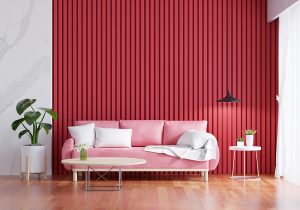
3. All Different Browns
People want to bring warmth to their homes as well as to add vitality to the space. Because brown is an earth tone, it gives us a sense of stability and closer ties to the natural world. People want to bring warmth into their homes, but they also want to add vitality, and browns can help a place feel both cozy and energetic.
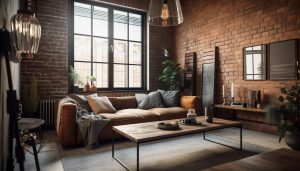
4. Gentle Violet
The design experts agree that lavender color is experiencing a renaissance and will become a popular trend in interior design in 2023.
It is often defined as the color of lavender, and the tenderness and softness of the violet make it a calming color, which is why we see it more and more often in bedrooms. This soft splash of color, when paired with luxurious decorations, could make your home look truly unique and lovely. A reading nook accessorized with this color would be the ultimate relaxation place.

5. Ultramarine Blue
One of the upcoming trends is ultramarine – a rich, bright blue color in all its shades. It is a hue that is vivid, highly concentrated and luxurious.
It is recommended to use this color in the interior design in combination with white, grey, soft purple, black or some other shade of blue. They are perfectly coordinated, which enables the creation of an elegant, provocative and confident space.

6. Raspberry Blush
Raspberry Blush is said to be the dominating bold color of 2023. This vibrant red orange is brimming with character and the interior designer’s advice is to try this brilliant color tone on the walls of a living room for a look that’s vivid, pleasant, and appealing. If you’re not ready yet to paint your walls raspberry red, consider using this color to give a worn-out piece of furniture a bold new look or make a striking art print to liven up a plain wall.

7. Jewel Tones
Gemstones shades like emerald green, petrol blue, ruby, offer sophistication. The suggestion is to mix them with pastel tones that you may already have in the apartment in the form of details for the decoration of the space and/or as a wall color in a room. Interior designers expect the colors of precious stones to be popular in 2023, which in combination with sharper colors, such as orange, create an unconventional appearance of the space. Try combining aubergine, a popular color this year, with cream and green shades to give an unconventional look to the space with a traditional feel. In addition, eggplant color is a shade of purple with a reddish tint, which is a great substitute for red.

8. Pastels
Professional interior designers predict that pastel colors, such as dusty blues, clays, and greens, will become highly prevalent in interior design. Everyone is enthusiastic about the comeback of pastels for color trends in 2023.These colors are associated with the awakening of spring, tenderness, optimism and a new beginning. They convey a feeling of softness, calmness and attractiveness. Powdery tones, the color of lavender, soft pink and yellow, pastel green and blue, will appeal to walls and furniture and all decorative elements in the interior. These colors’ palette is large and interior designers advise you to introduce more pastel shades into your home, create their combinations and adapt them to your style. Sometimes it is interesting to introduce more vivid or some darker colors that will add contrast and break the soft aesthetics of pastel shades. It all depends on what you want to achieve in your space.

9. The peace created by the colors and their temperature in the space
This year, the dominant shades that bring nature into the home will remain popular, because they are adaptable and the mixing of warm and cool tones, which is very easy to do in interior, stands out as a trend. It includes the use of turquoise or green, which go perfectly with beige shades. In some spaces, the combination of brilliant blue or purple tones with brown, cream and bronze tones creates a kind of harmony. The use of deep dark green to calm warm brown shades or dark orange tones with grey-blue, green or plum color gives an impression of prosperity, luxury, glamour and warmth.
The advice that interior designers especially emphasize is that if you are thinking about mixing warm and cool tones in space, you need to have a central theme. Never mix the different color temperatures in the room, the one should dominate. They highlighted the shade of white color – Cozy White, which evokes a feeling of comfort and security and transforms the living area into a recognizable and relaxed environment. In addition, most designers prefer the Southern Road color tone, which with its earthy tones stimulates the desire to stop for a moment to relax and enjoy the beauty of life as in nature.
Transforming a living place into a home that is attractive, welcoming and cozy remains a clear desire and is heavily influenced by the chosen colors. Trends in 2023 will prioritize comfort over anything else.The most important color trends in the interior design always were dedicated to the goal that the living space where you spend most of the day becomes your haven, fills you with positive energy, and brings peace and joy to all family members. We asked the experts – interior designers, and they selected the colors that give the walls in the space more than just aesthetics. Although it is a palette of rich color shades that are inspired by nature, they all contribute to experience the interior you are in like a warm, pleasant place to relax, which promotes a good mood and a higher level of attention of a person, which makes them an essential element of the interior.
-
History
Unlocking the Past: Discovering the Fascinating History of Office Spaces
From the humble beginnings of cramped desks and typewriters to the modern, vibrant work environments we see today, the history of office spaces is a captivating tale of innovation, culture, and the ever-evolving nature of work. Join us as we delve into the past and explore the fascinating milestones that have shaped the way we work today.
The Birth of Modern Offices: In the late 19th century, the industrial revolution sparked a significant shift in the way businesses operated. With the advent of telegraph and telephone technologies, the need for centralized workspaces arose.
The birth of modern offices can be traced back to this era, as companies began to establish centralized locations where employees could collaborate and work together efficiently.
The Rise of the Typewriter and Office Layouts:With the invention of the typewriter in the late 1800s, office spaces underwent a remarkable transformation. Typewriters replaced handwritten correspondence, leading to increased administrative tasks. To accommodate these new machines, office layouts were redesigned.
Open floor plans with rows of desks became common, fostering communication and collaboration among employees.

The Influence of Office Layouts on Work Culture: Throughout history, office layouts have played a crucial role in shaping work culture and employee dynamics. Different arrangements have emerged, each with its own impact on collaboration, productivity, and hierarchy within organizations.
From traditional closed-door offices to open floor plans, variations in office layouts have reflected the evolving philosophies of management and the changing expectations of employees. These designs have aimed to strike a balance between privacy and communication, fostering a sense of community while also allowing for focused individual work.
Technology’s Impact on Office Spaces: The rapid advancements in technology during the latter half of the 20th century had a profound impact on office spaces. The introduction of computers, fax machines, and later the internet transformed the way work was conducted. Physical documents and typewriters were gradually replaced by digital files and word processors, leading to a reduction in the need for storage and the physical footprint of offices.

Flexible and Remote Work Environments: In recent years, there has been a significant shift towards flexible and remote work environments. Technology advancements such as video conferencing, cloud storage, and collaboration tools have enabled employees to work from anywhere, blurring the boundaries of traditional office spaces.
This change has brought about new challenges and opportunities, emphasizing the importance of adaptability and work-life balance.
Modern Office Designs: Today, office designs have evolved to prioritize employee well-being and productivity. Companies are increasingly focusing on creating environments that foster creativity, collaboration, and employee satisfaction. Open floor plans, comfortable breakout spaces, ergonomic furniture, and recreational areas are becoming standard features in many workplaces.
Additionally, the integration of green spaces and natural elements has gained prominence, promoting a healthier and more sustainable work environment.
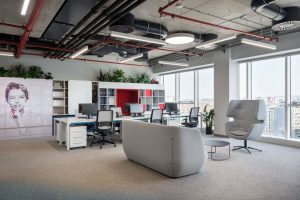
The history of office spaces is a testament to the ever-changing nature of work and the dynamic relationship between technology, culture, and design. From the industrial revolution to the digital age, office spaces have adapted and transformed to meet the evolving needs of businesses and employees.
As we move forward, the future of office spaces promises to be even more flexible, inclusive, and tailored to the needs of a diverse workforce. Exciting times lie ahead as we continue to redefine the way we work and reshape the office spaces of tomorrow.From the humble beginnings of cramped desks and typewriters to the modern, vibrant work environments we see today, the history of office spaces is a captivating tale of innovation, culture, and the ever-evolving nature of work. Join us as we delve into the past and explore the fascinating milestones that have shaped the way we work today.
The Birth of Modern Offices: In the late 19th century, the industrial revolution sparked a significant shift in the way businesses operated. With the advent of telegraph and telephone technologies, the need for centralized workspaces arose.
The birth of modern offices can be traced back to this era, as companies began to establish centralized locations where employees could collaborate and work together efficiently.
The Rise of the Typewriter and Office Layouts:With the invention of the typewriter in the late 1800s, office spaces underwent a remarkable transformation. Typewriters replaced handwritten correspondence, leading to increased administrative tasks. To accommodate these new machines, office layouts were redesigned.
Open floor plans with rows of desks became common, fostering communication and collaboration among employees.

The Influence of Office Layouts on Work Culture: Throughout history, office layouts have played a crucial role in shaping work culture and employee dynamics. Different arrangements have emerged, each with its own impact on collaboration, productivity, and hierarchy within organizations.
From traditional closed-door offices to open floor plans, variations in office layouts have reflected the evolving philosophies of management and the changing expectations of employees. These designs have aimed to strike a balance between privacy and communication, fostering a sense of community while also allowing for focused individual work.
Technology’s Impact on Office Spaces: The rapid advancements in technology during the latter half of the 20th century had a profound impact on office spaces. The introduction of computers, fax machines, and later the internet transformed the way work was conducted. Physical documents and typewriters were gradually replaced by digital files and word processors, leading to a reduction in the need for storage and the physical footprint of offices.

Flexible and Remote Work Environments: In recent years, there has been a significant shift towards flexible and remote work environments. Technology advancements such as video conferencing, cloud storage, and collaboration tools have enabled employees to work from anywhere, blurring the boundaries of traditional office spaces.
This change has brought about new challenges and opportunities, emphasizing the importance of adaptability and work-life balance.
Modern Office Designs: Today, office designs have evolved to prioritize employee well-being and productivity. Companies are increasingly focusing on creating environments that foster creativity, collaboration, and employee satisfaction. Open floor plans, comfortable breakout spaces, ergonomic furniture, and recreational areas are becoming standard features in many workplaces.
Additionally, the integration of green spaces and natural elements has gained prominence, promoting a healthier and more sustainable work environment.

The history of office spaces is a testament to the ever-changing nature of work and the dynamic relationship between technology, culture, and design. From the industrial revolution to the digital age, office spaces have adapted and transformed to meet the evolving needs of businesses and employees.
As we move forward, the future of office spaces promises to be even more flexible, inclusive, and tailored to the needs of a diverse workforce. Exciting times lie ahead as we continue to redefine the way we work and reshape the office spaces of tomorrow.
-
Advice
To Rent or Own Office Space: A Decision-Making Guide
One of the biggest decisions business owners face when it comes to office space is whether to rent or own. Both options have their advantages and disadvantages, and choosing the right one for your business can be challenging. In this post, we’ll explore the pros and cons of renting vs. owning office space to help you make an informed decision.

Upfront Costs:
When it comes to upfront costs, renting is generally the less expensive option. You’ll typically need to pay a security deposit and the first month’s rent, but you won’t be responsible for any major expenses like a down payment, closing costs, or renovations. On the other hand, owning office space requires a significant investment upfront. You’ll need to come up with a down payment, pay closing costs, and potentially invest in renovations or upgrades.
Flexibility:
Renting office space provides more flexibility than owning. If your business grows quickly, you can easily move to a larger space without having to worry about selling a property. Additionally, if your business needs change, you can easily move to a new location or adjust your lease terms. Owning, on the other hand, provides less flexibility. You’ll be tied to the property for the long term, and if your business needs change, it may be more difficult to sell or rent out the space.
Control:
Owning office space provides more control over the property. You can make changes and upgrades to the space as needed, and you can build equity over time. Additionally, owning can provide tax benefits, such as deductions for mortgage interest and property taxes. When you rent, you don’t have as much control over the property. You’ll need to get permission from the landlord to make changes or upgrades, and you won’t build equity in the property over time.
Maintenance:
When you own office space, you’re responsible for all maintenance and repairs. This can be costly and time-consuming, especially if you own an older building. When you rent, the landlord is typically responsible for maintenance and repairs. This means you won’t have to worry about things like HVAC repairs, roof maintenance, or landscaping. However, you may be responsible for minor repairs like fixing a leaky faucet or replacing light bulbs.

Long-Term Costs:
When you rent office space, you’re paying for the use of the space, but you don’t have any equity in the property. When you own, you’re building equity, but you’re also responsible for ongoing expenses such as property taxes, insurance, and maintenance. You’ll need to weigh the long-term costs of each option to determine which is best for your business. If you plan to stay in one location for a long time, owning may be a better option, but if you anticipate moving in the near future, renting may make more sense.
Conclusion
Deciding whether to rent or own office space is a complex decision that requires careful consideration of your business needs, budget, and long-term goals. By weighing the pros and cons of each option, you can make an informed decision that will benefit your business in the long run. Whether you choose to rent or own, remember that your office space is an important investment in the success of your business.One of the biggest decisions business owners face when it comes to office space is whether to rent or own. Both options have their advantages and disadvantages, and choosing the right one for your business can be challenging. In this post, we’ll explore the pros and cons of renting vs. owning office space to help you make an informed decision.

Upfront Costs:
When it comes to upfront costs, renting is generally the less expensive option. You’ll typically need to pay a security deposit and the first month’s rent, but you won’t be responsible for any major expenses like a down payment, closing costs, or renovations. On the other hand, owning office space requires a significant investment upfront. You’ll need to come up with a down payment, pay closing costs, and potentially invest in renovations or upgrades.
Flexibility:
Renting office space provides more flexibility than owning. If your business grows quickly, you can easily move to a larger space without having to worry about selling a property. Additionally, if your business needs change, you can easily move to a new location or adjust your lease terms. Owning, on the other hand, provides less flexibility. You’ll be tied to the property for the long term, and if your business needs change, it may be more difficult to sell or rent out the space.
Control:
Owning office space provides more control over the property. You can make changes and upgrades to the space as needed, and you can build equity over time. Additionally, owning can provide tax benefits, such as deductions for mortgage interest and property taxes. When you rent, you don’t have as much control over the property. You’ll need to get permission from the landlord to make changes or upgrades, and you won’t build equity in the property over time.
Maintenance:
When you own office space, you’re responsible for all maintenance and repairs. This can be costly and time-consuming, especially if you own an older building. When you rent, the landlord is typically responsible for maintenance and repairs. This means you won’t have to worry about things like HVAC repairs, roof maintenance, or landscaping. However, you may be responsible for minor repairs like fixing a leaky faucet or replacing light bulbs.

Long-Term Costs:
When you rent office space, you’re paying for the use of the space, but you don’t have any equity in the property. When you own, you’re building equity, but you’re also responsible for ongoing expenses such as property taxes, insurance, and maintenance. You’ll need to weigh the long-term costs of each option to determine which is best for your business. If you plan to stay in one location for a long time, owning may be a better option, but if you anticipate moving in the near future, renting may make more sense.
Conclusion
Deciding whether to rent or own office space is a complex decision that requires careful consideration of your business needs, budget, and long-term goals. By weighing the pros and cons of each option, you can make an informed decision that will benefit your business in the long run. Whether you choose to rent or own, remember that your office space is an important investment in the success of your business.
-
Advice
Light Up Your Workspace: The Benefits of Proper Lighting for Employee Wellness and Performance
Poor lighting can cause headaches, eye strain, and fatigue, while optimal lighting can promote alertness, reduce stress, and improve mood. In this article, we will explore the connection between lighting and office productivity and provide tips on how to optimize your lighting design.
Lighting can influence our productivity by regulating our circadian rhythms, which are the natural 24-hour cycles that govern our sleep-wake cycle. Exposure to bright, blue-rich light during the day can help to regulate our circadian rhythms, making us more alert and focused during the day and improving our sleep quality at night. On the other hand, exposure to dim or warm lighting can help to relax us, and prepare us for sleep.
Furthermore, lighting can affect our mood and emotional state. Exposure to bright, blue-rich light during the day can help to boost our mood and reduce feelings of fatigue. However, exposure to bright or harsh lighting at night can disrupt our circadian rhythms, leading to difficulty in falling asleep and poor sleep quality.Tips for Optimizing Your Lighting Design
To create an optimal lighting design, here are some tips to consider:-
Use Natural Light

Natural light is the best source of light for regulating our circadian rhythms. It can improve mood, boost alertness and reduce stress. Where possible, position workstations near windows to maximize the amount of natural light in the workspace. If your office doesn’t have natural light or if you want to supplement it, consider installing skylights or light tubes to bring natural light into the space.
-
Balance Brightness and Glare

While bright lighting can help to improve productivity, too much glare can cause eyestrain and headaches. To avoid this, use shades or blinds to reduce direct sunlight, and position light fixtures so that they do not shine directly into the eyes of workers. A balanced lighting design can reduce glare and promote optimal lighting levels, improving productivity and reducing discomfort.
-
Use the Right Color Temperature
The color temperature of light can also have an impact on productivity. During the day, use bright, blue-rich light (around 5000K) to help regulate circadian rhythms and improve alertness. In the evening, switch to warmer, dimmer lighting (around 2700K) to help workers wind down and prepare for sleep. Using the right color temperature can optimize the lighting levels to improve the productivity of workers.
-
Layer Your Lighting
To create a comfortable and inviting workspace, it’s important to use a variety of lighting sources. This could include overhead lighting, task lighting for individual workstations, and ambient lighting to create a warm, welcoming atmosphere. A layered lighting design can create a comfortable and productive workspace.
-
Consider Energy Efficiency

When designing your lighting system, it’s important to consider energy efficiency. Using energy-efficient bulbs such as LED or fluorescent bulbs can reduce energy consumption and lower energy bills. Additionally, installing motion sensors or timers can ensure that lights are only on when they are needed, reducing energy waste.
-
Design Lighting to Fit the Task
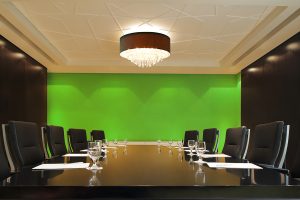
Different tasks require different levels and types of lighting. For example, computer work requires brighter lighting than reading or writing. Therefore, it’s important to design your lighting system to fit the task. Use task lighting at individual workstations to ensure that workers have the proper lighting levels for their specific tasks. Conference rooms may require dimmer lighting to promote a calm and focused atmosphere, while break rooms and common areas may benefit from brighter, more inviting lighting.
-
Consult with Professionals
Designing an effective lighting system can be a complex process. Therefore, it may be beneficial to consult with lighting professionals to ensure that your lighting design meets the needs of your workspace. A professional lighting designer can help you to identify the optimal lighting levels, lighting types, and lighting sources for your office space.
Lighting is a crucial element in the design of an office space, and it can have a significant impact on productivity, mood, and well-being. By using natural light, balancing brightness and glare, using the right color temperature, layering your lighting, considering energy efficiency, designing lighting to fit the task, and consulting with professionals, you can optimize your lighting design to create a comfortable and productive workspace.
Investing in a well-designed lighting system can pay off in improved productivity, reduced absenteeism, and increased job satisfaction. Therefore, it’s worth taking the time to create a lighting design that works for your specific office space and the needs of your employees.Poor lighting can cause headaches, eye strain, and fatigue, while optimal lighting can promote alertness, reduce stress, and improve mood. In this article, we will explore the connection between lighting and office productivity and provide tips on how to optimize your lighting design.
Lighting can influence our productivity by regulating our circadian rhythms, which are the natural 24-hour cycles that govern our sleep-wake cycle. Exposure to bright, blue-rich light during the day can help to regulate our circadian rhythms, making us more alert and focused during the day and improving our sleep quality at night. On the other hand, exposure to dim or warm lighting can help to relax us, and prepare us for sleep.
Furthermore, lighting can affect our mood and emotional state. Exposure to bright, blue-rich light during the day can help to boost our mood and reduce feelings of fatigue. However, exposure to bright or harsh lighting at night can disrupt our circadian rhythms, leading to difficulty in falling asleep and poor sleep quality.Tips for Optimizing Your Lighting Design
To create an optimal lighting design, here are some tips to consider:-
Use Natural Light

Natural light is the best source of light for regulating our circadian rhythms. It can improve mood, boost alertness and reduce stress. Where possible, position workstations near windows to maximize the amount of natural light in the workspace. If your office doesn’t have natural light or if you want to supplement it, consider installing skylights or light tubes to bring natural light into the space.
-
Balance Brightness and Glare

While bright lighting can help to improve productivity, too much glare can cause eyestrain and headaches. To avoid this, use shades or blinds to reduce direct sunlight, and position light fixtures so that they do not shine directly into the eyes of workers. A balanced lighting design can reduce glare and promote optimal lighting levels, improving productivity and reducing discomfort.
-
Use the Right Color Temperature
The color temperature of light can also have an impact on productivity. During the day, use bright, blue-rich light (around 5000K) to help regulate circadian rhythms and improve alertness. In the evening, switch to warmer, dimmer lighting (around 2700K) to help workers wind down and prepare for sleep. Using the right color temperature can optimize the lighting levels to improve the productivity of workers.
-
Layer Your Lighting
To create a comfortable and inviting workspace, it’s important to use a variety of lighting sources. This could include overhead lighting, task lighting for individual workstations, and ambient lighting to create a warm, welcoming atmosphere. A layered lighting design can create a comfortable and productive workspace.
-
Consider Energy Efficiency

When designing your lighting system, it’s important to consider energy efficiency. Using energy-efficient bulbs such as LED or fluorescent bulbs can reduce energy consumption and lower energy bills. Additionally, installing motion sensors or timers can ensure that lights are only on when they are needed, reducing energy waste.
-
Design Lighting to Fit the Task

Different tasks require different levels and types of lighting. For example, computer work requires brighter lighting than reading or writing. Therefore, it’s important to design your lighting system to fit the task. Use task lighting at individual workstations to ensure that workers have the proper lighting levels for their specific tasks. Conference rooms may require dimmer lighting to promote a calm and focused atmosphere, while break rooms and common areas may benefit from brighter, more inviting lighting.
-
Consult with Professionals
Designing an effective lighting system can be a complex process. Therefore, it may be beneficial to consult with lighting professionals to ensure that your lighting design meets the needs of your workspace. A professional lighting designer can help you to identify the optimal lighting levels, lighting types, and lighting sources for your office space.
Lighting is a crucial element in the design of an office space, and it can have a significant impact on productivity, mood, and well-being. By using natural light, balancing brightness and glare, using the right color temperature, layering your lighting, considering energy efficiency, designing lighting to fit the task, and consulting with professionals, you can optimize your lighting design to create a comfortable and productive workspace.
Investing in a well-designed lighting system can pay off in improved productivity, reduced absenteeism, and increased job satisfaction. Therefore, it’s worth taking the time to create a lighting design that works for your specific office space and the needs of your employees.
-
-
Workplace
The Human Connection: Why going in the office is essential for employees
As businesses continue to adapt to the ever-changing landscape of work, many are considering a return to the physical office. But with so many employees having experienced the flexibility and convenience of remote work, it begs the question: what is the value of working in an office? Here are six key benefits that might convince you to make the switch.
-
A Sense of Purpose and Belonging
Feeling connected to your work and your colleagues is important for job satisfaction. Being around like-minded individuals who share a common goal reinforces individual purpose within your organization. In-person collaboration allows employees to observe and learn from their peers, and celebrate victories together. Plus, face-to-face interactions build a sense of belonging that is difficult to achieve through virtual channels.
-
Real Connections and Friendships
For many, the camaraderie and friendships developed in the office is the biggest motivator for returning to work. It’s easier to bond over a shared love of coffee or happy hour in person than through video calls.

Studies show that remote workers often have fewer work friends than their office-bound counterparts. -
Increased Productivity
While remote work can be productive for some, many employees find that the physical workplace boosts productivity by providing easy access to information and equipment. In fact, 42% of employees say that the ability to access information quickly and easily boosts their productivity levels. Plus, the physical office can provide a clear purpose for employees to stay motivated.

-
Facilitates Collaboration
In-person collaboration and brainstorming is often more productive than virtual meetings.

Employees who work in an office spend more time collaborating than those who work from home, and they have the advantage of being able to access office equipment, whiteboards, and other tools that make collaboration easier. -
Better Onboarding Experience
In-person onboarding can provide new hires with an immersive and effective introduction to company culture, processes, and goals.

New employees can shadow colleagues that are more experienced, ask questions, and learn through observation. This makes them more confident in their roles and allows them to be productive more quickly. -
Career Growth Opportunities
Being in the physical workplace provides employees with greater exposure to senior leaders, who are more likely to take note of work done in the office than at home. This can lead to more opportunities for career growth and development.

Additionally, working in an office allows employees to learn new skills from their colleagues and observe how senior leaders handle different situations.
As the workplace continues to evolve, it is important to consider the value of working in an office. While remote work has many advantages, the physical office remains the hub of connection, collaboration, and innovation.
By fostering a sense of purpose and belonging, facilitating real connections and friendships, boosting productivity, facilitating collaboration, improving the onboarding experience, and driving career growth, the physical workplace can be an essential component of a thriving organization.
-
-
Workplace
6 ways to make an office space visually appealing.
We spend a large portion of our day at work and it’s crucial that our surroundings inspire us to be productive and content. An uninviting workspace can decrease your motivation and productivity.That’s why CBS International is here to offer 6 simple tips to enhance your office space to increase productivity.
-
Ergonomic design
Before decorating your office, consider the different work styles and needs of employees. Some may prefer a desk with an L-shape to alternate between tasks, while others might opt for a counter-height desk. Create a space that caters to each individual’s work style.
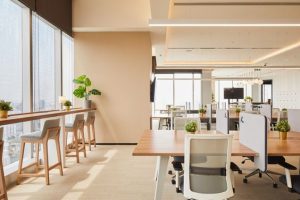
Ergonomic design extends beyond furniture and includes visual and audio elements. Traditional office lighting can cause strain on the eyes and create glare on computer screens. Ensure lighting is not too harsh but still allows for efficient work.
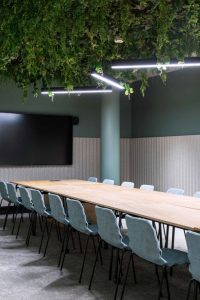
-
Minimalist approach
A cluttered space can lead to a cluttered mind, so it’s essential to keep furniture to a minimum. Create a clean and inspiring environment to start your workday with focus. Avoid stacking files and supplies on your desk and instead implement organized storage solutions. Choose sleek furniture instead of heavy and bulky pieces to maintain a neat appearance.
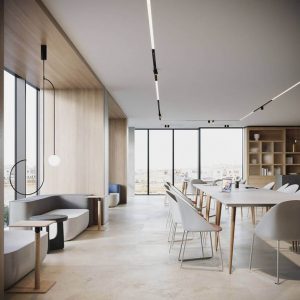
-
Color scheme
Choose colors wisely when decorating your office. Some colors can lift your mood and increase productivity, while others can make you feel low and demotivated. Grey, beige, and white can create a dull and gloomy atmosphere, while greens and blues promote focus and efficiency.
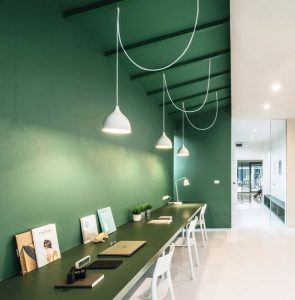
Yellow is a bright color that boosts confidence. Although a whole room of yellow may be overwhelming, a well-placed accent wall in the right setting can inspire passion and enhance your mood. Consider mimicking your brand’s color scheme, but opt for lighter shades for paint colors.
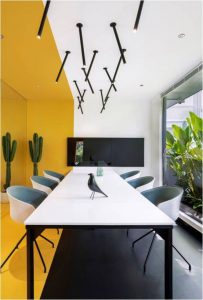
-
Illuminate your space
Poor lighting can make you feel tired and gloomy. Ensure ample lighting in your work area, including placing desks near windows to maximize natural light. Use sheer curtains instead of heavy blinds to allow natural light to enter the space.
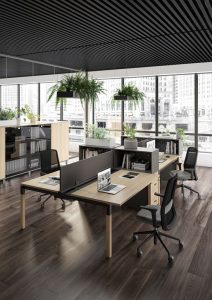
Traditional fluorescent office lights can be draining and even cause headaches. Consider using incandescent bulbs, white LED lights, and lamps to brighten your office.
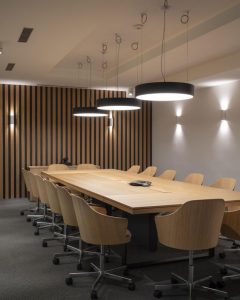
-
Bring in nature
Incorporating plants into your office can bring life and freshness to the space.
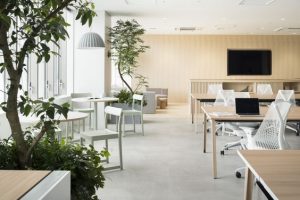
For larger offices with access to natural light, opt for statement plants. If you work in a cubicle, utilize wall space to hang plants. If you have limited space on your desk, consider small succulents and flowers to decorate your workspace.
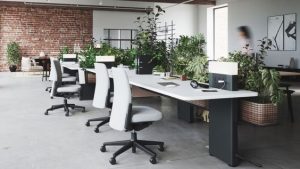
-
Expert assistance
Decorating your office on your own can be challenging, so don’t hesitate to seek professional advice. A skilled interior designer can assist with planning an ergonomic space that fits your needs.
Take advantage of CBS International Commercial Design Consultation for a personalized design plan for your office. CBS International offers seamless solutions for your office interiors.
Having a workspace that is comfortable and inspiring is important for a successful workday. Use these tips when decorating your office to create a space that feels like home.
We spend a large portion of our day at work and it’s crucial that our surroundings inspire us to be productive and content. An uninviting workspace can decrease your motivation and productivity.That’s why CBS International is here to offer 6 simple tips to enhance your office space to increase productivity.
-
-
Advice
Dilemma: New vs Old Construction
When purchasing an apartment, people tend to consider its location, structure, floor position, view from the apartment, proximity to educational and health institutions, and whether there is parking and building maintenance.
When all these apartment characteristics fulfill expectations and personal financials do not represent an obstacle, there is still an eternal dilemma: whether to purchase a property within a newly built building, or old construction?
It is not easy to solve such dilemma, as both new and old construction have its advantages, therefore it is recommended to consult with real estate agencies.
FEATURES
New Construction
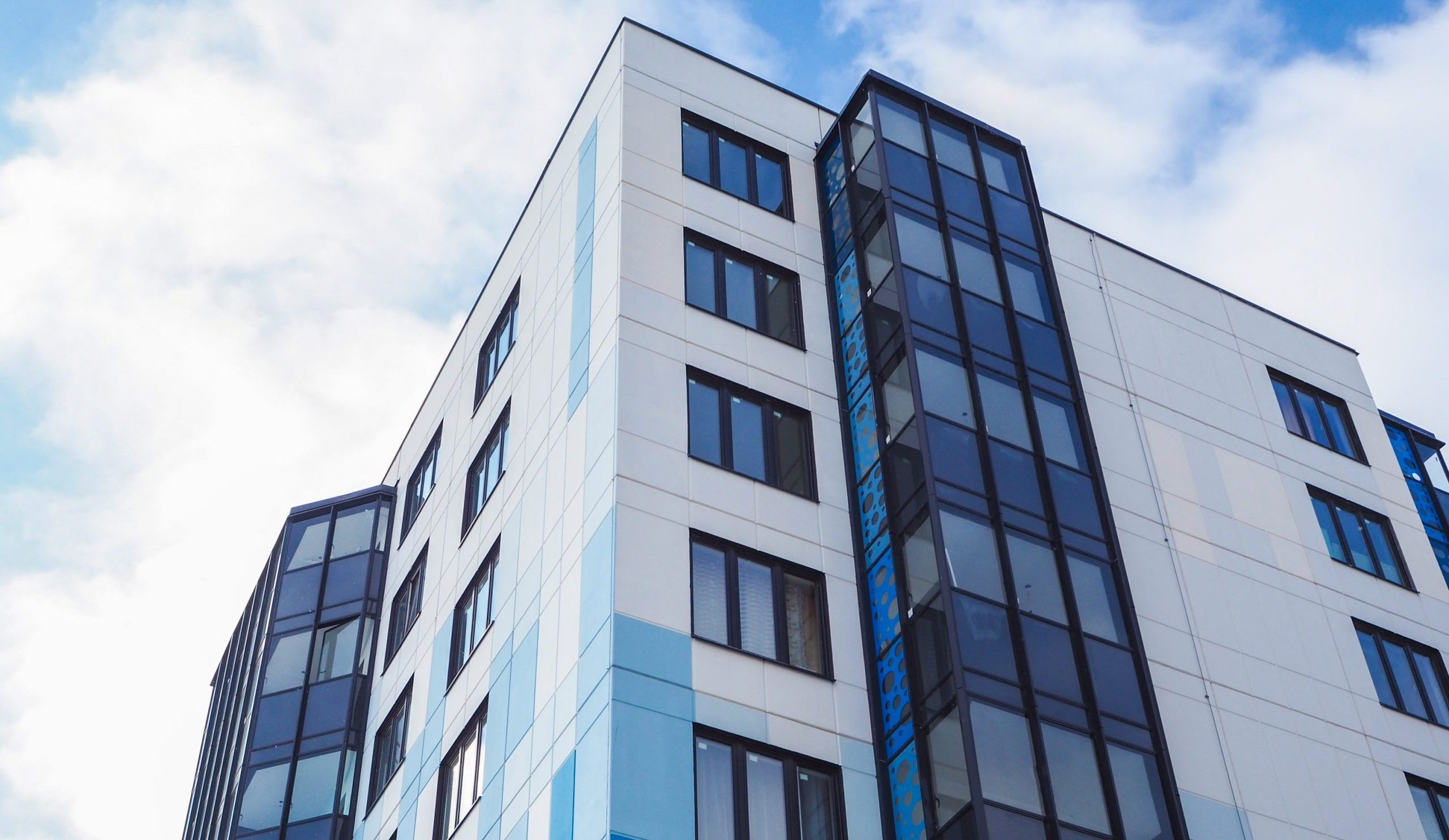
Modern beautiful new buildings. New apartments have many advantages, and the most important advantage is exactly that – it is a new apartment in a new building, with all new installations and built-in materials, and more often investors give a guarantee to clients for the work and equipment.
Newly built apartments don’t need renovation, and thanks to building regulations and the materials used, today’s residential buildings are more energy efficient, which results in lower maintenance costs and monthly overhead costs.
Besides this, apartments are adapted to today’s lifestyle. Modern interior design implies open space, less hallways, while a kitchen, dining and living rooms are basically one whole, thus the space is used with more functionality.
New construction in urban areas today has solved the issue of parking, mostly in the form of an underground garage, meanwhile larger residential complexes contain a variety of amenities available for residents.
Safety which newly built buildings provide represents one of the top priorities for a majority of investors. New buildings have modern methods of monitoring the building through video intercoms, card access to the entrance and garage, video surveillance. Professional security is increasingly present in the building 24/7, which increases the safety and sense of security for you and your household.
Concrete is predominantly used in new construction nowadays, thus it is believed that this “cold” material cannot replace the former brick buildings. However, new buildings are built according to the latest standards and have extremely high-quality thermal, hydro and sound insulation.
For the construction of modern, new residential buildings, better quality materials are used, and at the same time, new technology and a new way of construction of living space are used. Mainly, during the construction of new buildings, the needs of a modern lifestyle are also met.
Old Construction

Facade of a traditional apartment building The main advantage of old construction is the price, which is usually lower compared to new construction. The period in which the building is being built and the interior design of the apartment will make the property more affordable, while the location and additional renovation work could make the price higher.
The condition of the apartment also affects the price. Many apartments in older buildings are being renovated to make them more attractive to the market. If you are interested in such an apartment, it is recommended that you inform yourself in detail about works and adaptations.
However, it is important not to overlook that additional adaptations to the old apartment require larger investments. In addition to money, it also takes time to find quality contractors who will carry out the renovation within the stipulated time.
Another advantage is that the apartment is ready, available and ready for immediate occupancy, there are no worries about completing the construction of the building, and in most cases it has valid ownership documentation.
Older apartments have a traditional room layout where each room is separated from the other by walls. There may also be some kind of storage room, a larger hallway, often the ceilings are higher, so the apartment may seem larger compared to an apartment of the same square footage in a new building. In addition, older buildings usually have basements, which is not often the case with newly constructed buildings.
Many properties built in the previous period were built according to the plan, which means that the buildings are far enough from traffic roads, there are parking spaces for tenants, parks, green areas. Older properties are built from high quality durable and natural materials and often have high arches and thick walls.
Previously, construction workers used materials such as steel, wood, brick and concrete, which were considered to be their main advantage. However, due to the date of construction, it is recommended to check what materials were used in the construction, as well as the condition of the installations and carpentry in the apartment.
Adaptation according to wishes and capabilities!
When buying real estate, people are trying to adjust their wants and desires according to their budget. However, what happens when a certain structure of the apartment needs a little correction? Is that possible?
One of the most important advantages of buying a building in a building under construction is the ability to influence the layout of the rooms and participate in modification works and adapt the apartment to your needs.
If the layout of the interior is not exactly what the buyer expected, or wishes to rearrange the space in their home, these changes are possible and easier to implement while the residential complex is under construction.
In the case of apartments with an older construction date, it is generally possible to move, demolish or raise partition walls in order for the residents to adapt the layout of the rooms to their wishes and requirements. However, it is recommended to consult a professional who will review the project and provide proof in the form of a static calculation so that the wishes can be brought into reality, and only then proceed with the adaptation of the apartment. Every adjustment costs money, so the renovation of an old apartment implies certain investments.
How to come up with the final decision?
The final decision when solving the housing issue is mostly influenced by personal wishes and possibilities. While some buyers love the charm of older apartments, other clients are more attracted to the smell of a new home, open space and modern design. Considering the importance of the decision to enter the process of buying an apartment, it would still be good to consult real estate experts.Are you aware of the fact that an apartment purchase is one of the most important life decisions? Because of that, it is important to take into consideration all aspects before making the final decision. When purchasing an apartment, people tend to consider its location, structure, floor position, view from the apartment, proximity to educational and health institutions, and whether there is parking and building maintenance.
When all these apartment characteristics fulfill expectations and personal financials do not represent an obstacle, there is still an eternal dilemma: whether to purchase a property within a newly built building, or old construction?
It is not easy to solve such dilemma, as both new and old construction have its advantages, therefore it is recommended to consult with real estate agencies.
